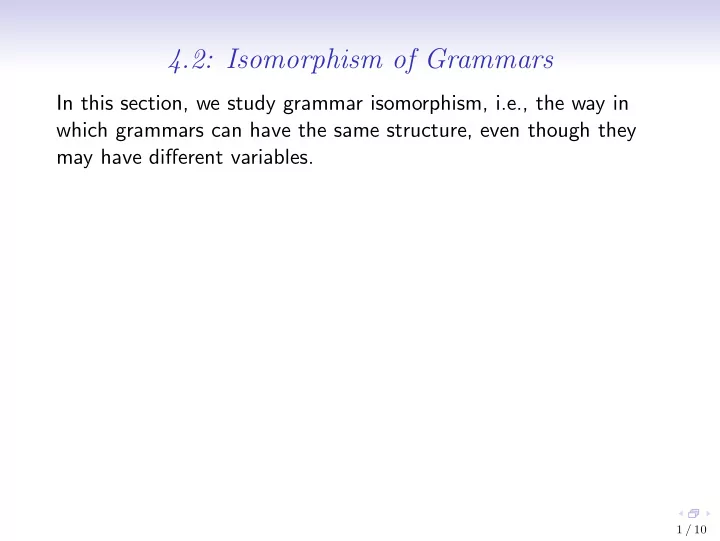

4.2: Isomorphism of Grammars In this section, we study grammar isomorphism, i.e., the way in which grammars can have the same structure, even though they may have different variables. 1 / 10
Definition and Algorithm Suppose G is the grammar with variables A and B, start variable A and productions: A → 0A1 | B , B → % | 2A . And, suppose H is the grammar with variables B and A, start variable B and productions: B → 0B1 | A , A → % | 2B . Question: how are G and H related? Answer: H can be formed from G by renaming the variables A and B of G to B and A, respectively. As a result, we say that G and H are isomorphic. 2 / 10
On the Subtlety of Isomorphism Suppose G is as before, but that H is the grammar with variables 2 and A, start variable 2 and productions: 2 → 021 | A , A → % | 22 . Then H can be formed from G by renaming the variables A and B to 2 and A, respectively. Question: should we consider G and H to be isomorphic? Answer: no—the symbol 2 is in both alphabet G and Q H . In fact, G and H generate different languages. A grammar’s variables (e.g., A) can’t be renamed to elements of the grammar’s alphabet (e.g., 2). 3 / 10
Definition of Isomorphism An isomorphism h from a grammar G to a grammar H is a bijection from Q G to Q H such that: • h turns G into H ; • alphabet G ∩ Q H = ∅ , i.e., none of the symbols in G ’s alphabet are variables of H . We say that G and H are isomorphic iff there is an isomorphism between G and H . As expected, we have that the relation of being isomorphic is reflexive on Gram , symmetric and transitive, and that isomorphism implies having the same alphabet and equivalence. There is an algorithm for finding an isomorphism from one grammar to another, if one exists, or reporting that there is no such isomorphism. It’s similar to the algorithm for finding an isomorphism between finite automata. 4 / 10
Renaming Variables The function renameVariables takes in a pair ( G , f ), where G is a grammar and f is a bijection from Q G to a set of symbols with the property that range f ∩ alphabet G = ∅ , and returns the grammar produced from G by renaming G ’s variables using the bijection f . The resulting grammar will be isomorphic to G . 5 / 10
Renaming Variables The following function is a special case of renameVariables . The function renameVariablesCanonically ∈ Gram → Gram renames the variables of a grammar G to: • A, B, etc., when the grammar has no more than 26 variables (the smallest variable of G will be renamed to A, the next smallest one to B, etc.); or • � 1 � , � 2 � , etc., otherwise. These variables will actually be surrounded by a uniform number of extra brackets, if this is needed to make the new grammar’s variables and the original grammar’s alphabet be disjoint. 6 / 10
Isomorphism Finding/Checking in Forlan The Forlan module Gram contains the following functions for finding and processing isomorphisms in Forlan: val isomorphism : gram * gram * sym_rel -> bool val findIsomorphism : gram * gram -> sym_rel val isomorphic : gram * gram -> bool val renameVariables : gram * sym_rel -> gram val renameVariablesCanonically : gram -> gram 7 / 10
Forlan Examples Suppose the identifier gram of type gram is bound to the grammar with variables A and B, start variable A and productions: A → 0A1 | B , B → % | 2A . Suppose the identifier gram’ of type gram is bound to the grammar with variables B and A, start variable B and productions: B → 0B1 | A , A → % | 2B . And, suppose the identifier gram’’ of type gram is bound to the grammar with variables 2 and A, start variable 2 and productions: 2 → 021 | A , A → % | 22 . 8 / 10
Forlan Examples Here are some examples of how the above functions can be used: - val rel = Gram.findIsomorphism(gram, gram’); val rel = - : sym_rel - SymRel.output("", rel); (A, B), (B, A) val it = () : unit - Gram.isomorphism(gram, gram’, rel); val it = true : bool - Gram.isomorphic(gram, gram’’); val it = false : bool - Gram.isomorphic(gram’, gram’’); val it = false : bool 9 / 10
Forlan Examples - val gram = Gram.input ""; @ {variables} B, C @ {start variable} B @ {productions} B -> AC; C -> <A> @ . val gram = - : gram - SymSet.output("", Gram.alphabet gram); A, <A> val it = () : unit - Gram.output = ("", Gram.renameVariablesCanonically gram); {variables} <<A>>, <<B>> {start variable} <<A>> {productions} <<A>> -> A<<B>>; <<B>> -> <A> val it = () : unit 10 / 10
Recommend
More recommend